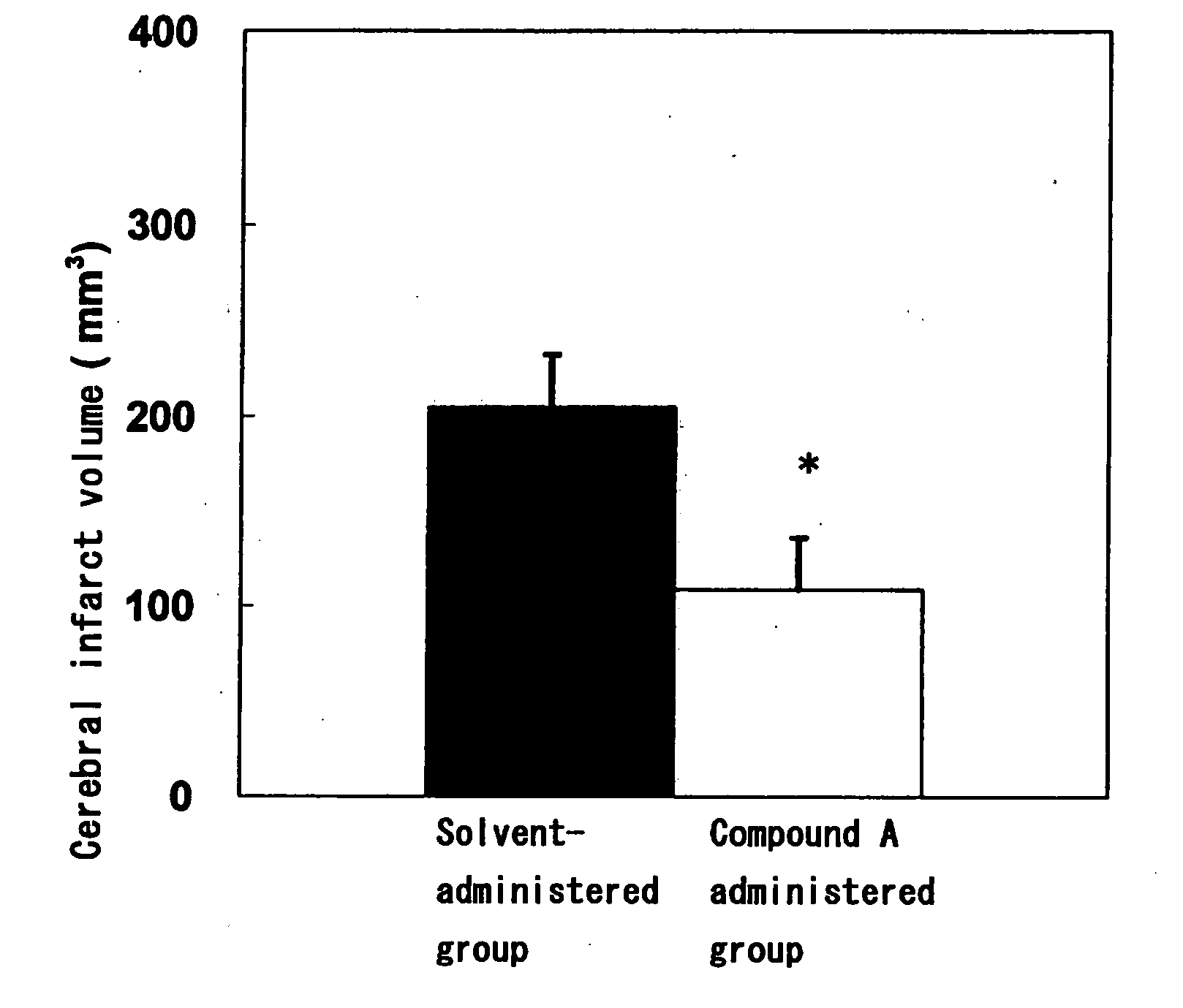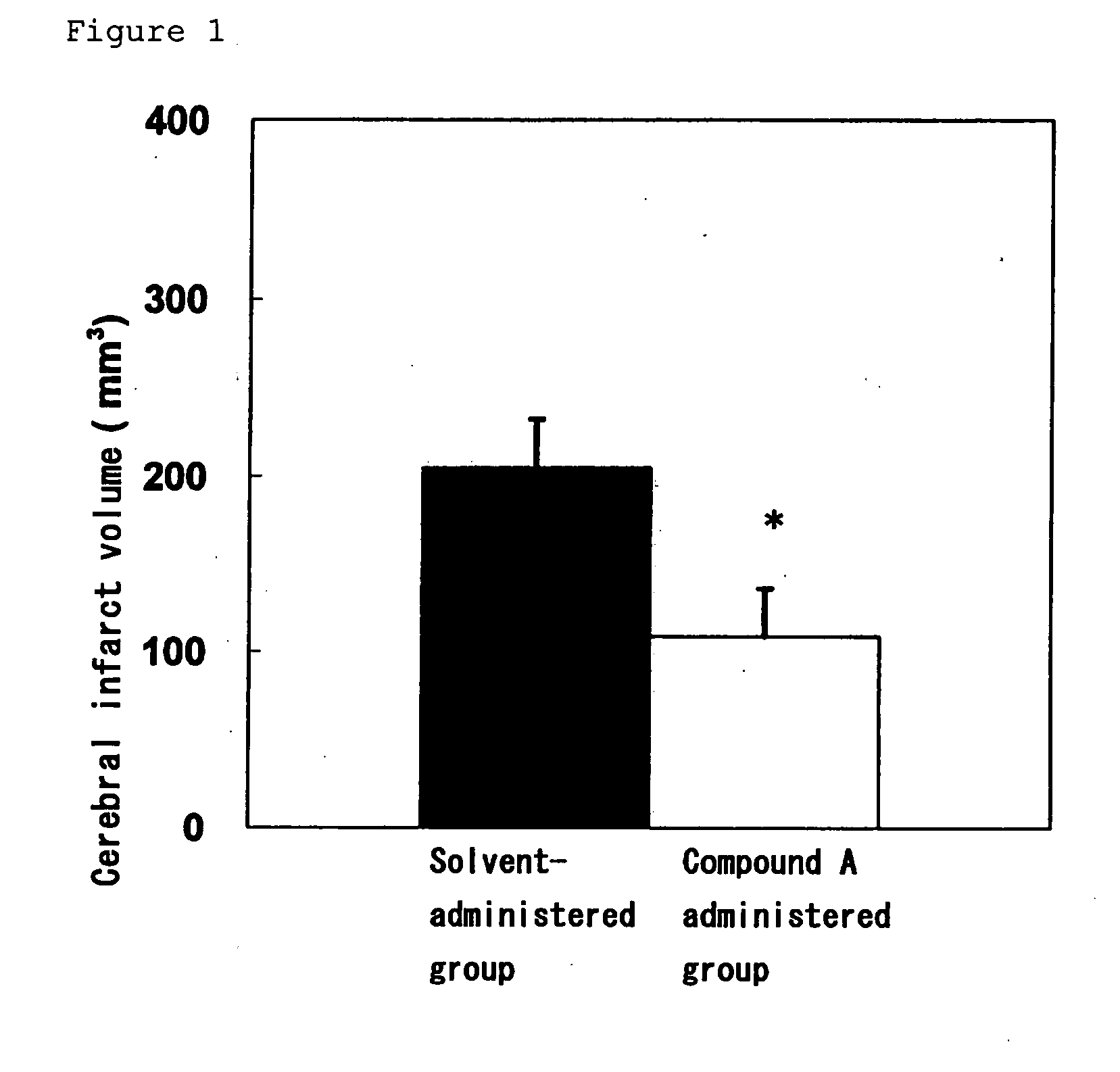Amide Compound
a technology of amide and compound, which is applied in the field of new cerebroprotective agents, can solve the problems of ineffective treatment and cerebroprotection drugs targeting radical treatment, ischemic stress on the cells of the central nervous system, and limited benefit group of subjects, etc., and achieves excellent faah inhibitory activity, useful in prevention and/or treatment of sleep disorders
- Summary
- Abstract
- Description
- Claims
- Application Information
AI Technical Summary
Benefits of technology
Problems solved by technology
Method used
Image
Examples
example 1
N-1,2-Benzisoxazol-3-yl-4-(3-phenyl-1,2,4-thiadiazol-5-yl)piperazine-1-carboxamide
(1) 1,2-Benzisoxazol-3-amine
[0280]To a solution of acetohydroxamic acid (10.0 g, 133 mmol) in N,N-dimethylformamide (150 ml) was added potassium tert-butoxide (14.9 g, 133 mmol), and the mixture was stirred at room temperature for 30 minutes. 2-Fluorobenzonitrile (18.0 g, 133 mmol) was added thereto, followed by stirring at room temperature for 5 hours. The reaction mixture was poured to water and extracted with ethyl acetate. The extract was washed with water and dried over anhydrous magnesium sulfate, and the solvent was distilled off under reduced pressure. The residue was recrystallized from hexane to give 4.80 g (27.0%) of the desired product as a solid.
[0281]1H-NMR (CDCl3) δ; 4.43 (2H, br s), 7.23-7.28 (1H, m), 7.43 (1H, d, J=9.3 Hz), 7.50-7.56 (2H, m).
(2) Bis(2,2,2-trichloroethyl) 1,2-benzisoxazol-3-ylimidodicarbonate
[0282]To a solution of 1,2-benzisoxazol-3-amine (4.00 g, 29.8 mmol) and pyridin...
example 2
N-1,2-Benzisoxazol-3-yl-4-[3-(4-fluorophenyl)-1,2,4-thiadiazol-5-yl]piperazine-1-carboxamide
[0290]To a solution of 5-chloro-3-(4-fluorophenyl)-1,2,4-thiadiazole (119 mg, 0.555 mmol) and N-1,2-benzisoxazol-3-ylpiperazine-1-carboxamide trifluoroacetate (200 mg, 0.555 mmol) in N,N-dimethylformamide (2 ml) was added triethylamine (0.389 ml, 2.78 mmol) at room temperature, and the mixture was stirred at room temperature for 2 hours. The reaction mixture was poured to water, and the precipitated solid was separated by filtration, which was recrystallized from a mixed solvent of ethyl acetate and tetrahydrofuran to give 114 mg (48.5%) of the desired product.
[0291]1H-NMR (DMSO-d6) δ; 3.70-3.73 (8H, m), 7.29-7.35 (3H, m), 7.61-7.64 (2H, m), 7.86 (1H, d, J=7.8 Hz), 8.15-8.19 (2H, m), 10.11 (1H, s).
example 3
N-1,2-Benzisoxazol-3-yl-4-[3-(3-fluorophenyl)-1,2,4-thiadiazol-5-yl]piperazine-1-carboxamide
[0292]To a solution of 5-chloro-3-(3-fluorophenyl)-1,2,4-thiadiazole (119 mg, 0.555 mmol) and N-1,2-benzisoxazol-3-ylpiperazine-1-carboxamide trifluoroacetate (200 mg, 0.555 mmol) in N,N-dimethylformamide (2 ml) was added triethylamine (0.389 ml, 2.78 mmol) at room temperature, and the mixture was stirred at room temperature for 2 hours. The reaction mixture was poured to water, and the precipitated solid was separated by filtration, which was recrystallized from a mixed solvent of ethyl acetate and tetrahydrofuran to give 132 mg (56.2%) of the desired product.
[0293]1H-NMR (DMSO-d6) δ; 3.71-3.73 (8H, m), 7.30-7.37 (2H, m), 7.51-7.67 (3H, m), 7.83-7.88 (2H, m), 7.97 (1H, d, J=7.8 Hz), 10.11 (1H, s).
PUM
 Login to View More
Login to View More Abstract
Description
Claims
Application Information
 Login to View More
Login to View More - R&D
- Intellectual Property
- Life Sciences
- Materials
- Tech Scout
- Unparalleled Data Quality
- Higher Quality Content
- 60% Fewer Hallucinations
Browse by: Latest US Patents, China's latest patents, Technical Efficacy Thesaurus, Application Domain, Technology Topic, Popular Technical Reports.
© 2025 PatSnap. All rights reserved.Legal|Privacy policy|Modern Slavery Act Transparency Statement|Sitemap|About US| Contact US: help@patsnap.com



